Consumer Behaviour Presentation: Path to Purchase and Decision-Making
VerifiedAdded on 2023/06/04
|12
|1237
|209
Presentation
AI Summary
This presentation provides a comprehensive overview of consumer behaviour, focusing on the decision-making process and the path to purchase. It begins with an introduction to the concept of consumer behaviour, followed by an examination of the five-stage model of consumer decision-making. The presentation emphasizes the value of mapping the path to purchase and explores different levels of consumer decision-making, including extensive, limited, and routine problem-solving. Furthermore, it delves into four distinct views of consumer decision-making: economic, cognitive, emotional, and passive. The presentation also addresses factors influencing decision-making, such as new technological implementations and the marketing mix, including product, price, place, and promotion. The content is supported by a list of relevant references, providing a solid foundation for understanding consumer behaviour in a business context.
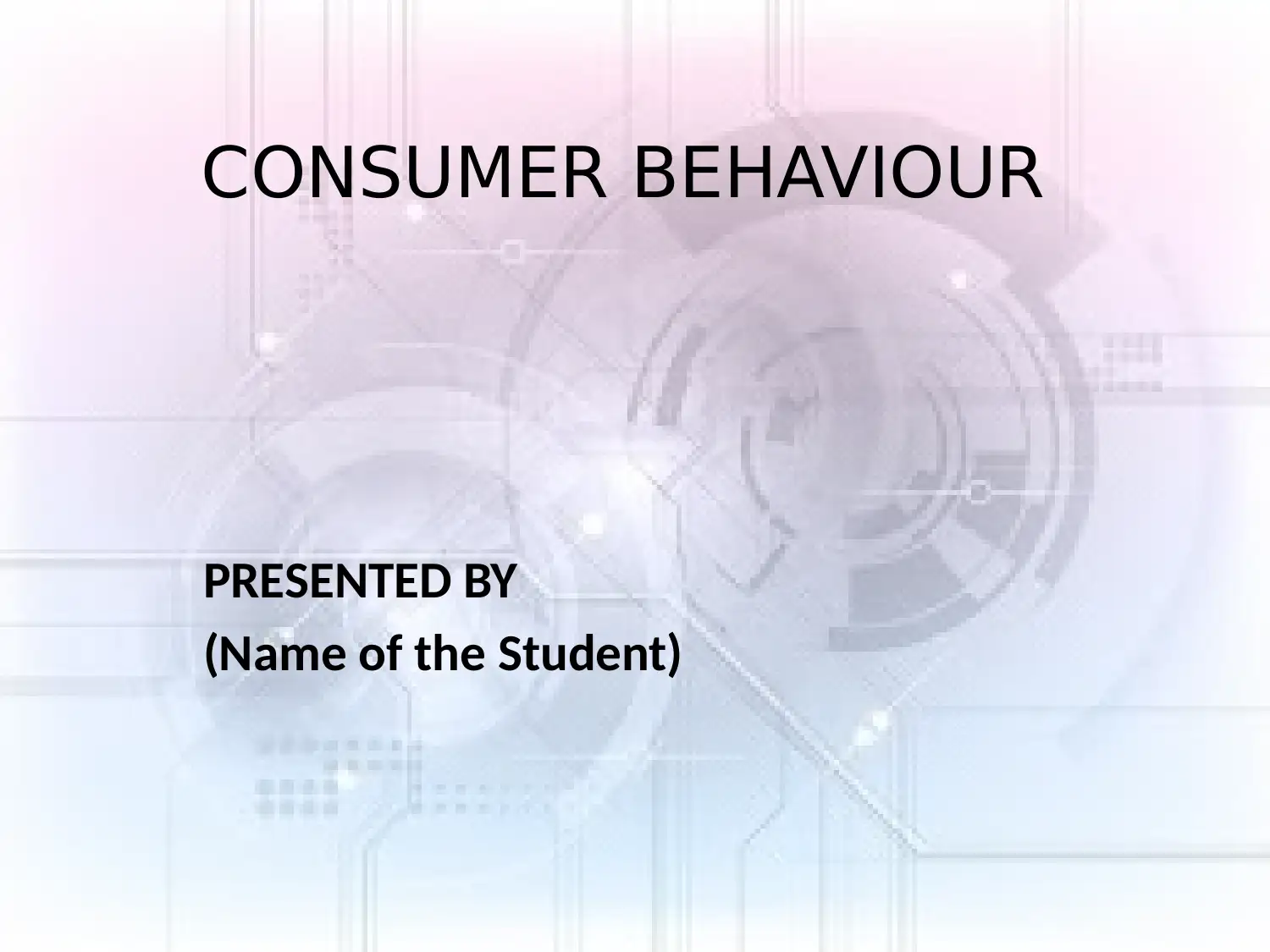
CONSUMER BEHAVIOUR
PRESENTED BY
(Name of the Student)
PRESENTED BY
(Name of the Student)
Paraphrase This Document
Need a fresh take? Get an instant paraphrase of this document with our AI Paraphraser
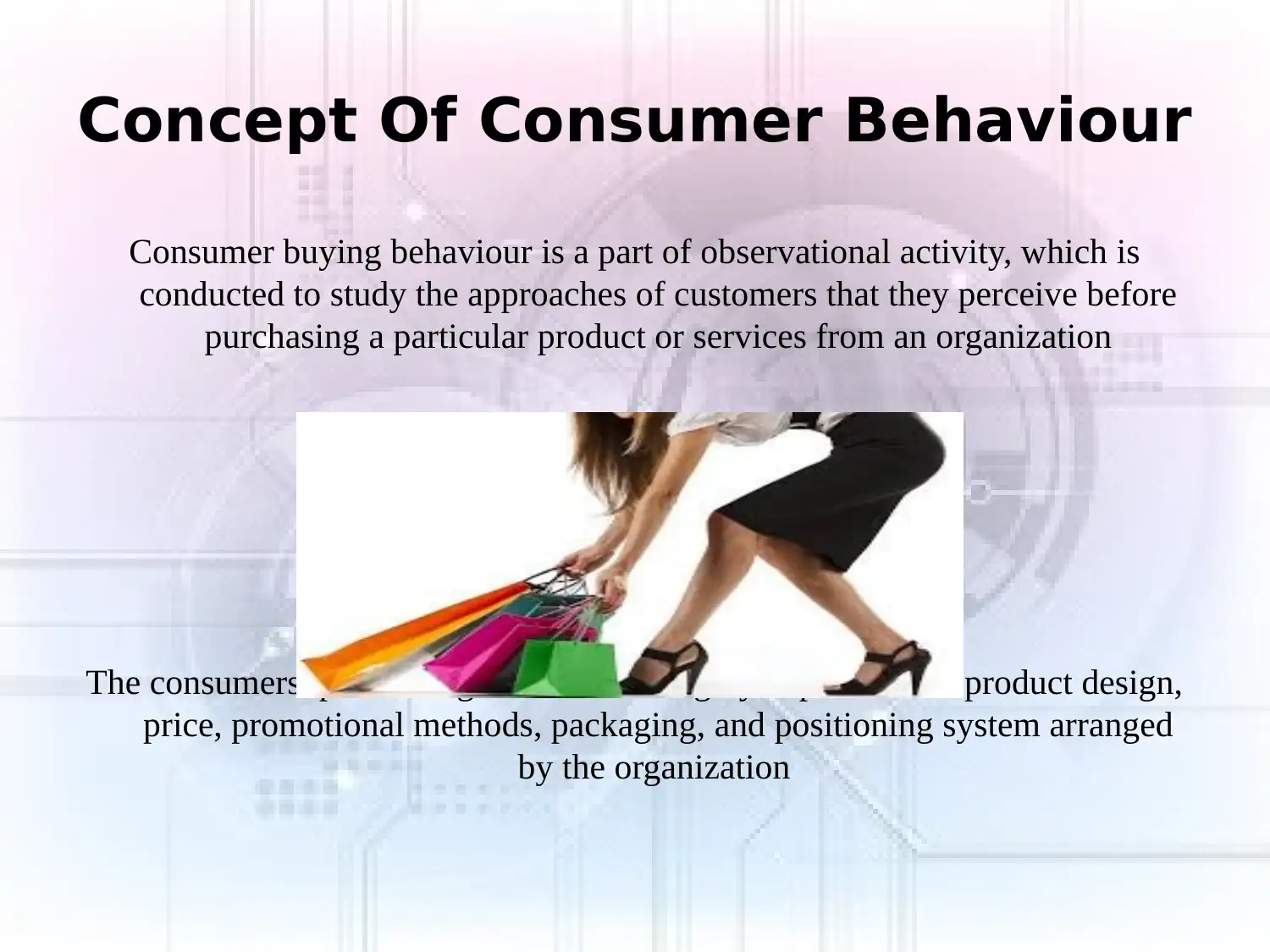
Concept Of Consumer Behaviour
Consumer buying behaviour is a part of observational activity, which is
conducted to study the approaches of customers that they perceive before
purchasing a particular product or services from an organization
The consumers’ purchasing behaviour is highly dependent on product design,
price, promotional methods, packaging, and positioning system arranged
by the organization
Consumer buying behaviour is a part of observational activity, which is
conducted to study the approaches of customers that they perceive before
purchasing a particular product or services from an organization
The consumers’ purchasing behaviour is highly dependent on product design,
price, promotional methods, packaging, and positioning system arranged
by the organization
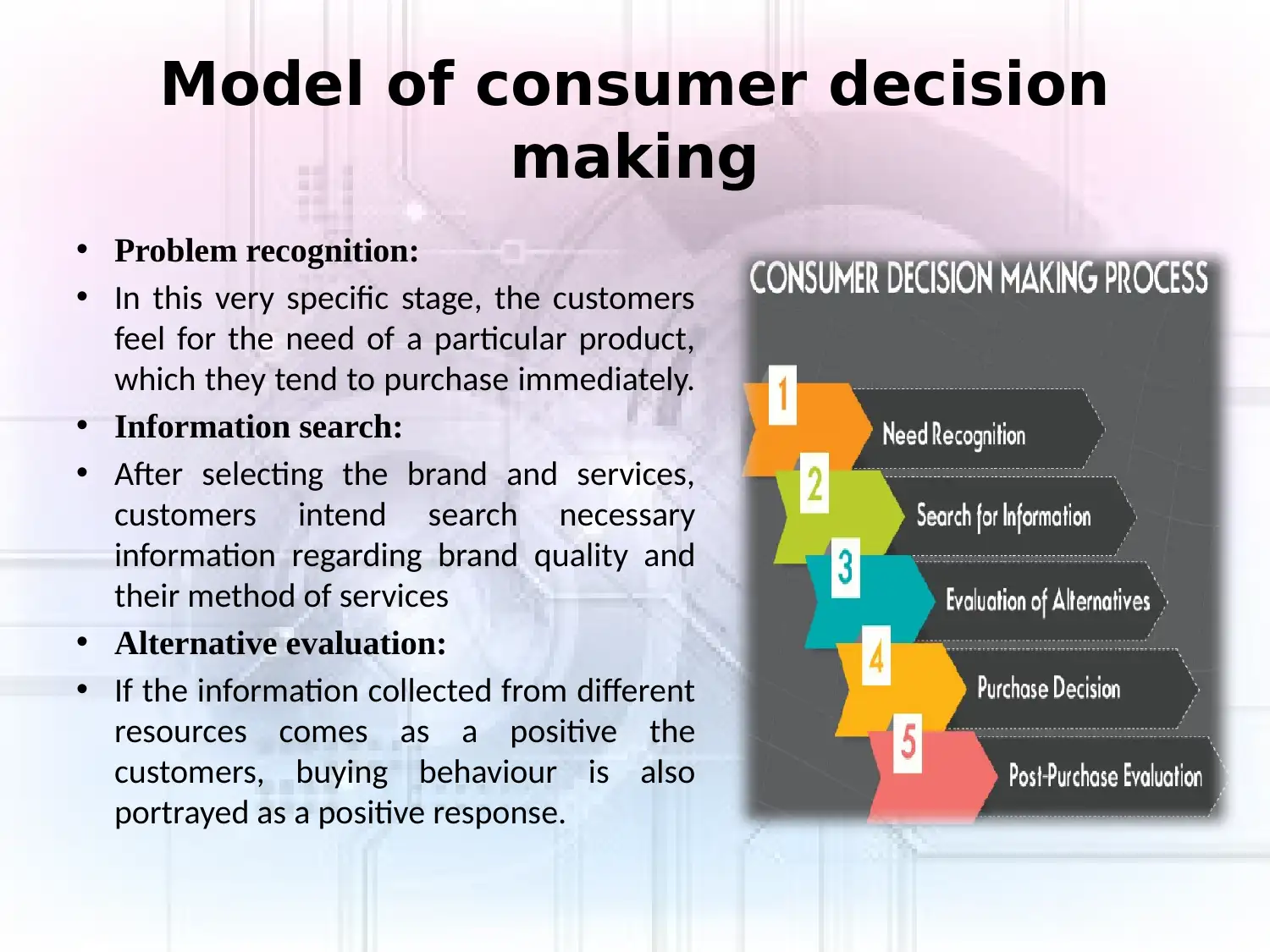
Model of consumer decision
making
• Problem recognition:
• In this very specific stage, the customers
feel for the need of a particular product,
which they tend to purchase immediately.
• Information search:
• After selecting the brand and services,
customers intend search necessary
information regarding brand quality and
their method of services
• Alternative evaluation:
• If the information collected from different
resources comes as a positive the
customers, buying behaviour is also
portrayed as a positive response.
making
• Problem recognition:
• In this very specific stage, the customers
feel for the need of a particular product,
which they tend to purchase immediately.
• Information search:
• After selecting the brand and services,
customers intend search necessary
information regarding brand quality and
their method of services
• Alternative evaluation:
• If the information collected from different
resources comes as a positive the
customers, buying behaviour is also
portrayed as a positive response.
⊘ This is a preview!⊘
Do you want full access?
Subscribe today to unlock all pages.

Trusted by 1+ million students worldwide

Model of consumer decision
making
• Purchase decision:
• Purchasing decision is highly dependent on
two previous stages mentioned above. If the
information collected from different media
tools seem to be positive the customers’
intend to show their positive purchasing
decision
• Post-purchase behaviour:
• Post purchasing behaviour is the phase when
customers share their point of view regarding
their overall impression about the product or
services. Post purchasing behaviour may be
positive or negative which completely
depends on the customers’ perception about
the brands.
making
• Purchase decision:
• Purchasing decision is highly dependent on
two previous stages mentioned above. If the
information collected from different media
tools seem to be positive the customers’
intend to show their positive purchasing
decision
• Post-purchase behaviour:
• Post purchasing behaviour is the phase when
customers share their point of view regarding
their overall impression about the product or
services. Post purchasing behaviour may be
positive or negative which completely
depends on the customers’ perception about
the brands.
Paraphrase This Document
Need a fresh take? Get an instant paraphrase of this document with our AI Paraphraser
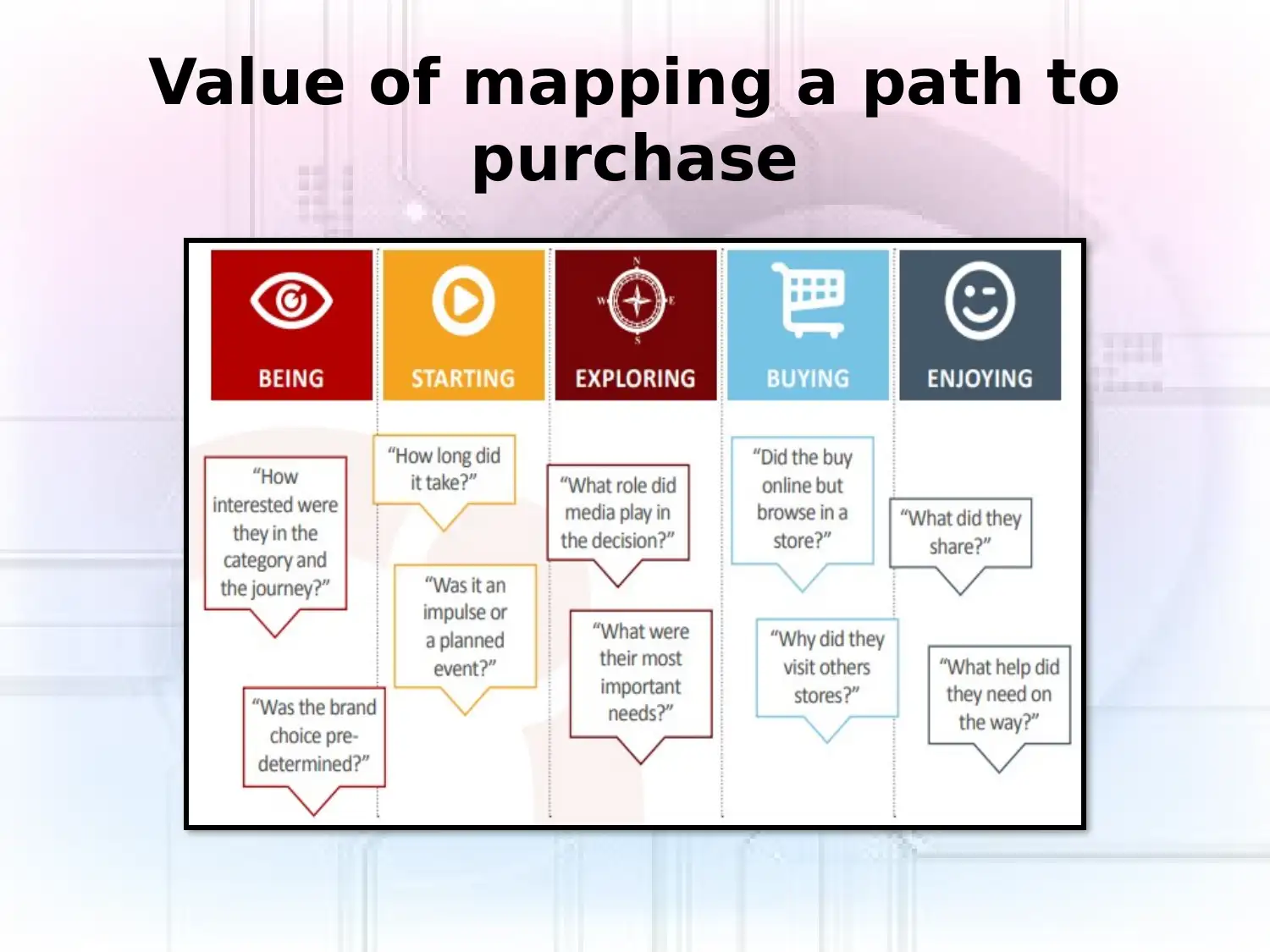
Value of mapping a path to
purchase
purchase
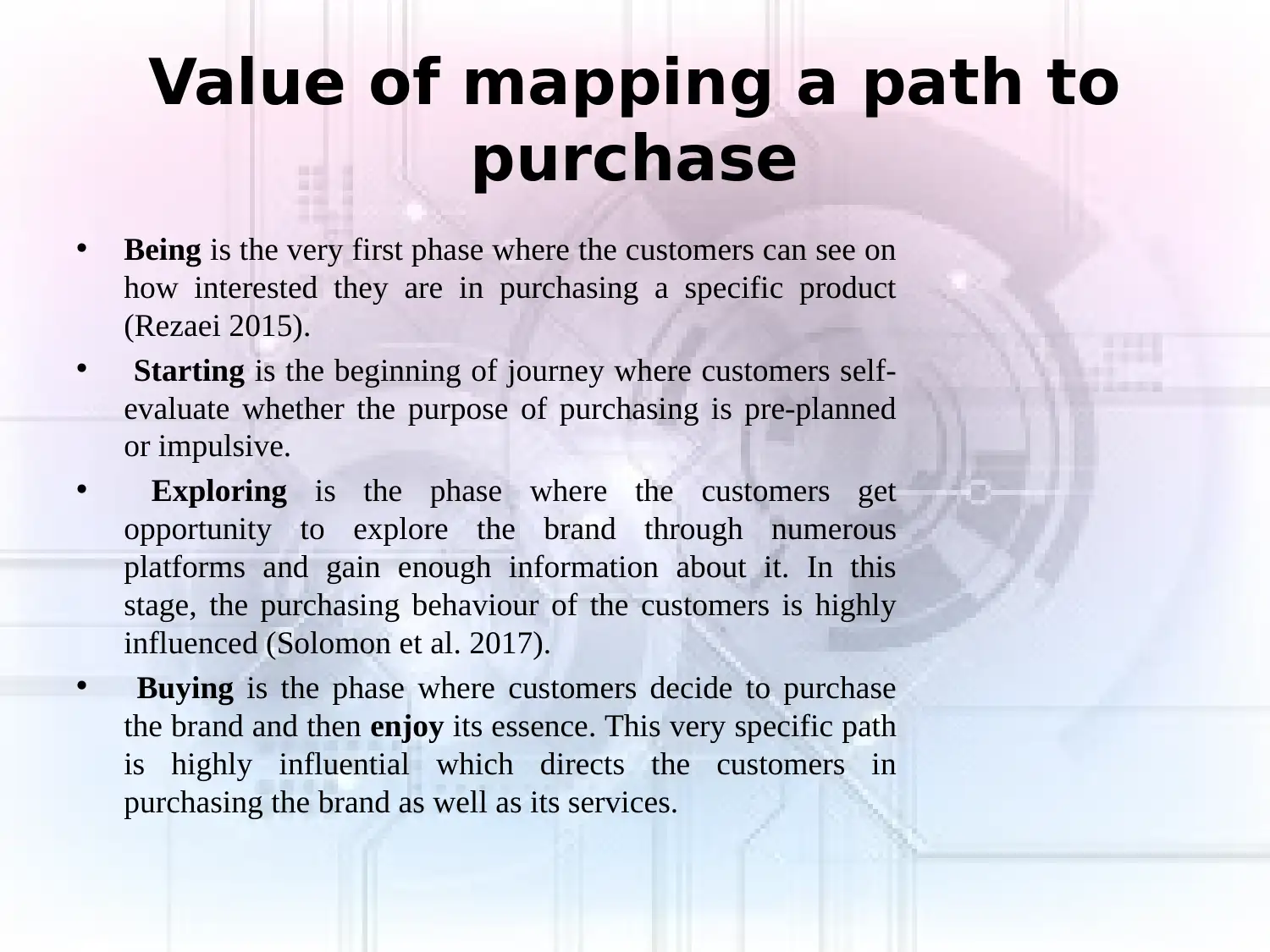
Value of mapping a path to
purchase
• Being is the very first phase where the customers can see on
how interested they are in purchasing a specific product
(Rezaei 2015).
• Starting is the beginning of journey where customers self-
evaluate whether the purpose of purchasing is pre-planned
or impulsive.
• Exploring is the phase where the customers get
opportunity to explore the brand through numerous
platforms and gain enough information about it. In this
stage, the purchasing behaviour of the customers is highly
influenced (Solomon et al. 2017).
• Buying is the phase where customers decide to purchase
the brand and then enjoy its essence. This very specific path
is highly influential which directs the customers in
purchasing the brand as well as its services.
purchase
• Being is the very first phase where the customers can see on
how interested they are in purchasing a specific product
(Rezaei 2015).
• Starting is the beginning of journey where customers self-
evaluate whether the purpose of purchasing is pre-planned
or impulsive.
• Exploring is the phase where the customers get
opportunity to explore the brand through numerous
platforms and gain enough information about it. In this
stage, the purchasing behaviour of the customers is highly
influenced (Solomon et al. 2017).
• Buying is the phase where customers decide to purchase
the brand and then enjoy its essence. This very specific path
is highly influential which directs the customers in
purchasing the brand as well as its services.
⊘ This is a preview!⊘
Do you want full access?
Subscribe today to unlock all pages.

Trusted by 1+ million students worldwide
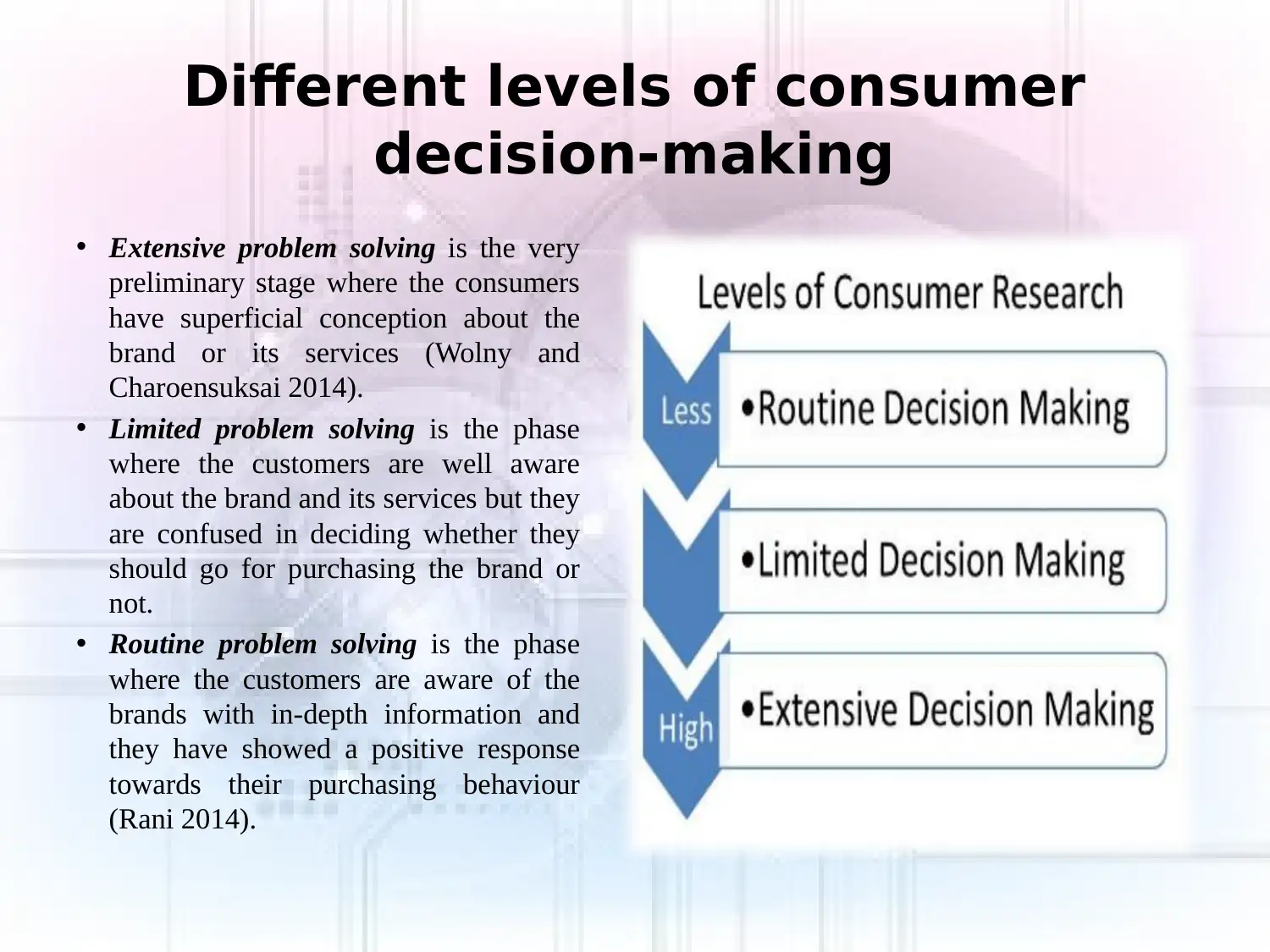
Different levels of consumer
decision-making
• Extensive problem solving is the very
preliminary stage where the consumers
have superficial conception about the
brand or its services (Wolny and
Charoensuksai 2014).
• Limited problem solving is the phase
where the customers are well aware
about the brand and its services but they
are confused in deciding whether they
should go for purchasing the brand or
not.
• Routine problem solving is the phase
where the customers are aware of the
brands with in-depth information and
they have showed a positive response
towards their purchasing behaviour
(Rani 2014).
decision-making
• Extensive problem solving is the very
preliminary stage where the consumers
have superficial conception about the
brand or its services (Wolny and
Charoensuksai 2014).
• Limited problem solving is the phase
where the customers are well aware
about the brand and its services but they
are confused in deciding whether they
should go for purchasing the brand or
not.
• Routine problem solving is the phase
where the customers are aware of the
brands with in-depth information and
they have showed a positive response
towards their purchasing behaviour
(Rani 2014).
Paraphrase This Document
Need a fresh take? Get an instant paraphrase of this document with our AI Paraphraser
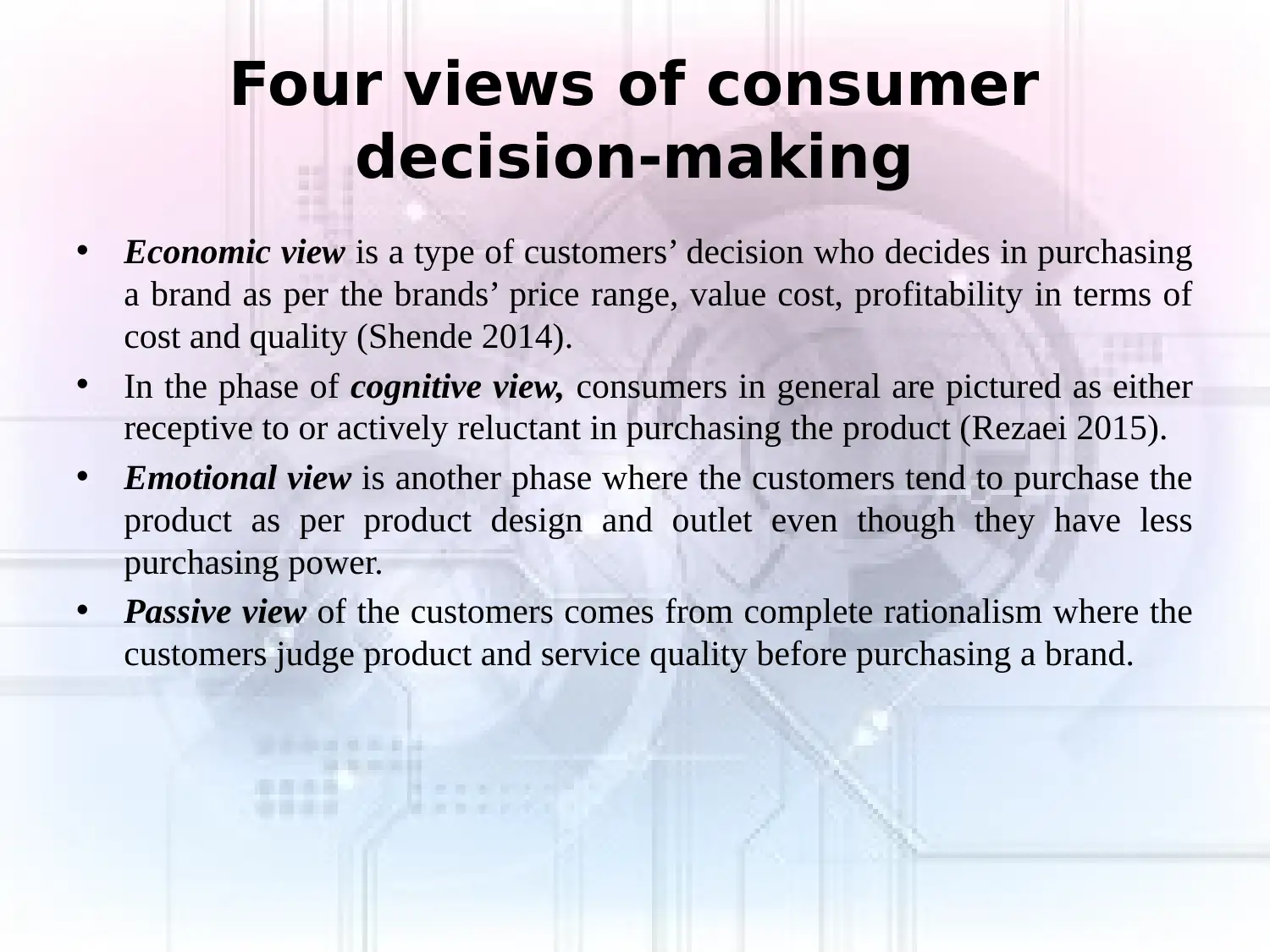
Four views of consumer
decision-making
• Economic view is a type of customers’ decision who decides in purchasing
a brand as per the brands’ price range, value cost, profitability in terms of
cost and quality (Shende 2014).
• In the phase of cognitive view, consumers in general are pictured as either
receptive to or actively reluctant in purchasing the product (Rezaei 2015).
• Emotional view is another phase where the customers tend to purchase the
product as per product design and outlet even though they have less
purchasing power.
• Passive view of the customers comes from complete rationalism where the
customers judge product and service quality before purchasing a brand.
decision-making
• Economic view is a type of customers’ decision who decides in purchasing
a brand as per the brands’ price range, value cost, profitability in terms of
cost and quality (Shende 2014).
• In the phase of cognitive view, consumers in general are pictured as either
receptive to or actively reluctant in purchasing the product (Rezaei 2015).
• Emotional view is another phase where the customers tend to purchase the
product as per product design and outlet even though they have less
purchasing power.
• Passive view of the customers comes from complete rationalism where the
customers judge product and service quality before purchasing a brand.
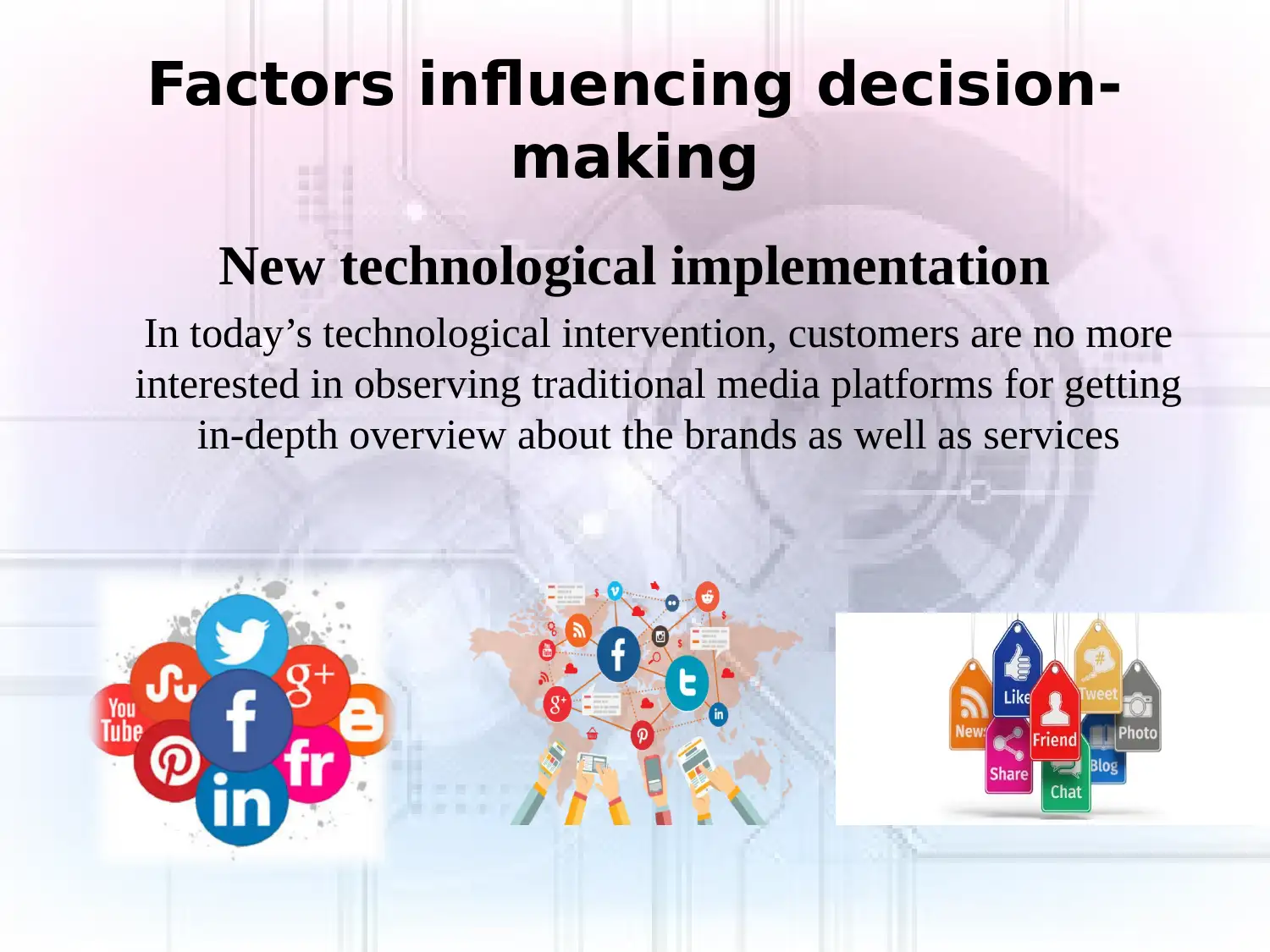
Factors influencing decision-
making
New technological implementation
In today’s technological intervention, customers are no more
interested in observing traditional media platforms for getting
in-depth overview about the brands as well as services
making
New technological implementation
In today’s technological intervention, customers are no more
interested in observing traditional media platforms for getting
in-depth overview about the brands as well as services
⊘ This is a preview!⊘
Do you want full access?
Subscribe today to unlock all pages.

Trusted by 1+ million students worldwide
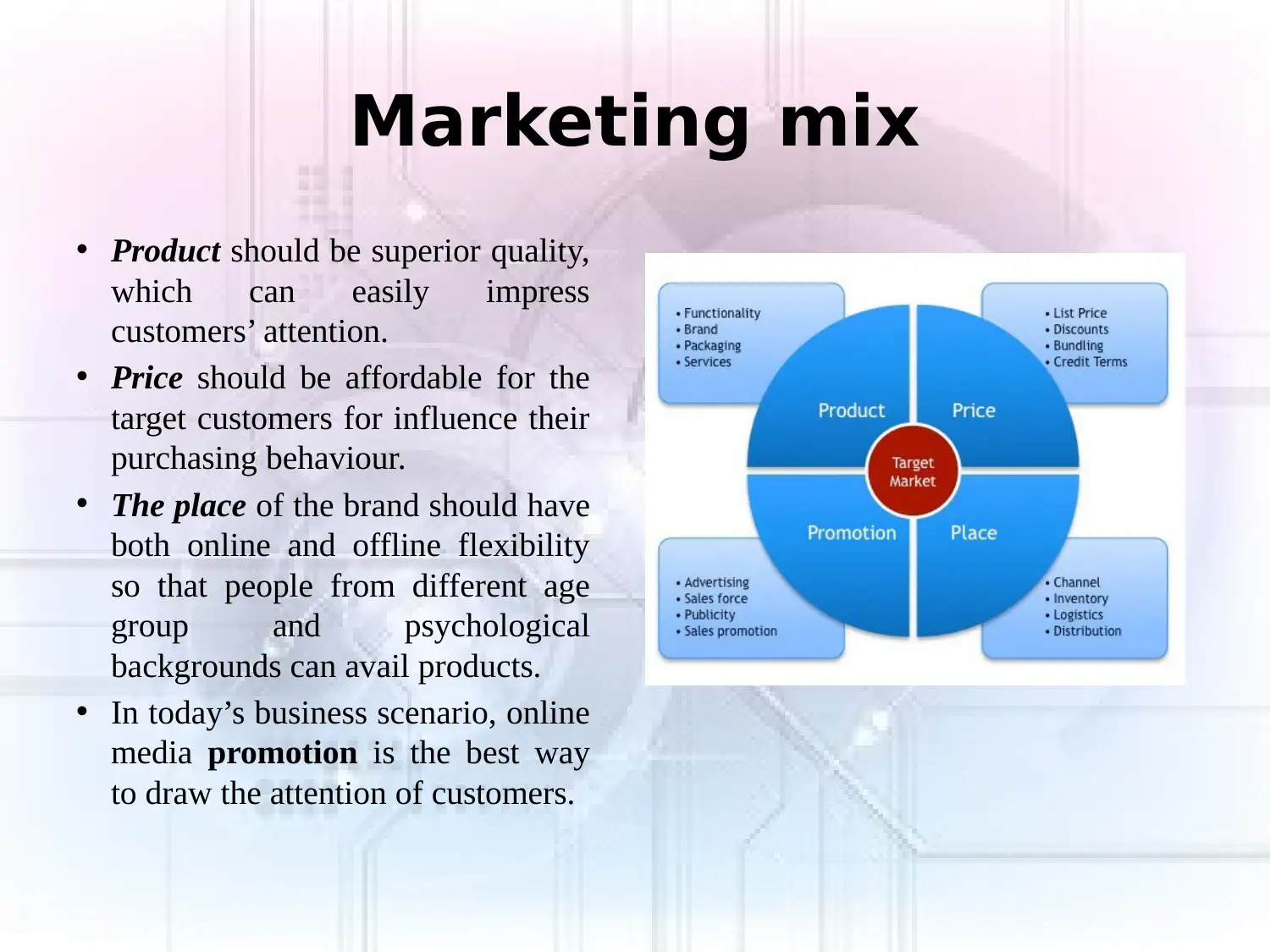
Marketing mix
• Product should be superior quality,
which can easily impress
customers’ attention.
• Price should be affordable for the
target customers for influence their
purchasing behaviour.
• The place of the brand should have
both online and offline flexibility
so that people from different age
group and psychological
backgrounds can avail products.
• In today’s business scenario, online
media promotion is the best way
to draw the attention of customers.
• Product should be superior quality,
which can easily impress
customers’ attention.
• Price should be affordable for the
target customers for influence their
purchasing behaviour.
• The place of the brand should have
both online and offline flexibility
so that people from different age
group and psychological
backgrounds can avail products.
• In today’s business scenario, online
media promotion is the best way
to draw the attention of customers.
Paraphrase This Document
Need a fresh take? Get an instant paraphrase of this document with our AI Paraphraser
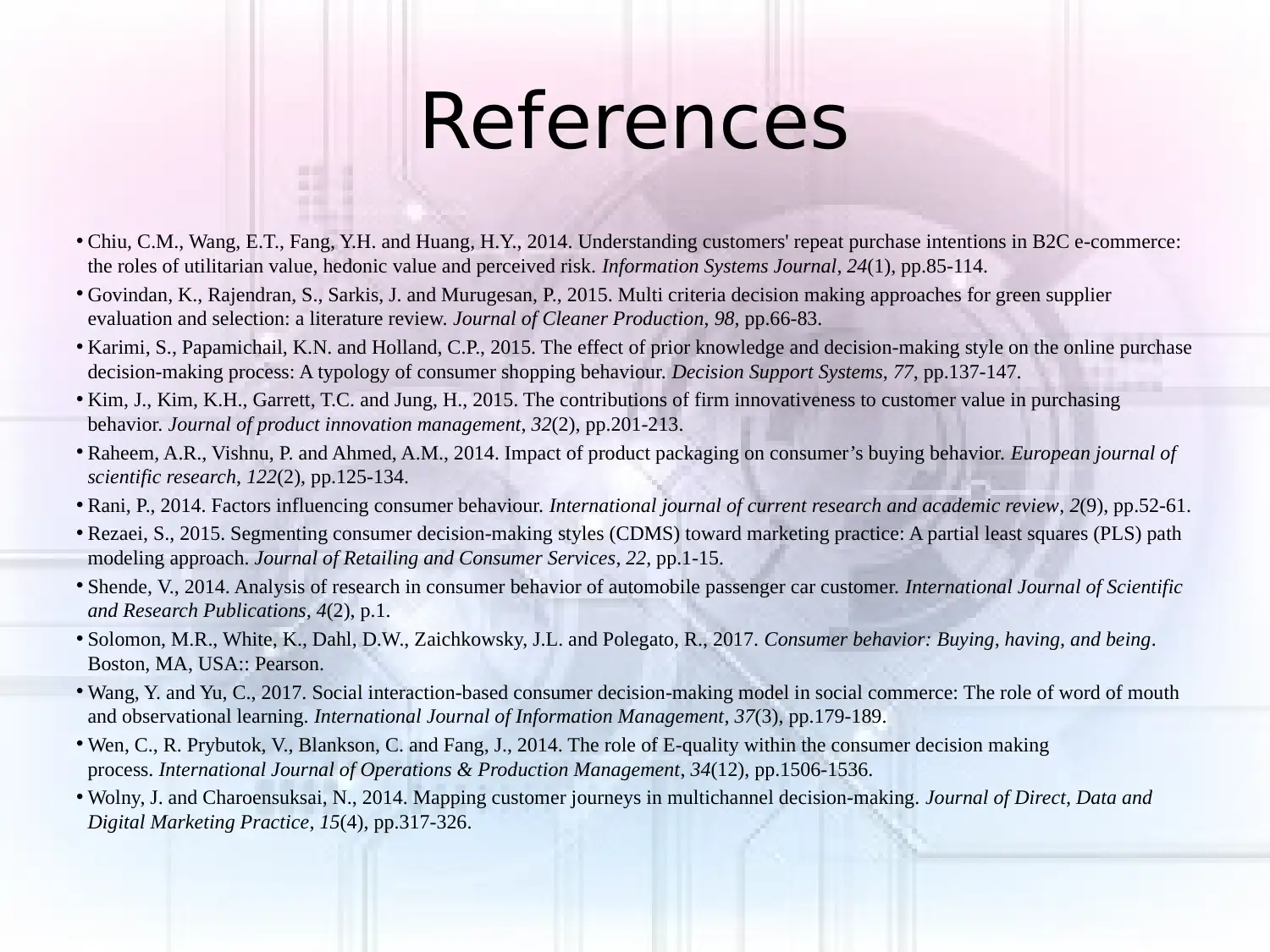
References
• Chiu, C.M., Wang, E.T., Fang, Y.H. and Huang, H.Y., 2014. Understanding customers' repeat purchase intentions in B2C e‐commerce:
the roles of utilitarian value, hedonic value and perceived risk. Information Systems Journal, 24(1), pp.85-114.
• Govindan, K., Rajendran, S., Sarkis, J. and Murugesan, P., 2015. Multi criteria decision making approaches for green supplier
evaluation and selection: a literature review. Journal of Cleaner Production, 98, pp.66-83.
• Karimi, S., Papamichail, K.N. and Holland, C.P., 2015. The effect of prior knowledge and decision-making style on the online purchase
decision-making process: A typology of consumer shopping behaviour. Decision Support Systems, 77, pp.137-147.
• Kim, J., Kim, K.H., Garrett, T.C. and Jung, H., 2015. The contributions of firm innovativeness to customer value in purchasing
behavior. Journal of product innovation management, 32(2), pp.201-213.
• Raheem, A.R., Vishnu, P. and Ahmed, A.M., 2014. Impact of product packaging on consumer’s buying behavior. European journal of
scientific research, 122(2), pp.125-134.
• Rani, P., 2014. Factors influencing consumer behaviour. International journal of current research and academic review, 2(9), pp.52-61.
• Rezaei, S., 2015. Segmenting consumer decision-making styles (CDMS) toward marketing practice: A partial least squares (PLS) path
modeling approach. Journal of Retailing and Consumer Services, 22, pp.1-15.
• Shende, V., 2014. Analysis of research in consumer behavior of automobile passenger car customer. International Journal of Scientific
and Research Publications, 4(2), p.1.
• Solomon, M.R., White, K., Dahl, D.W., Zaichkowsky, J.L. and Polegato, R., 2017. Consumer behavior: Buying, having, and being.
Boston, MA, USA:: Pearson.
• Wang, Y. and Yu, C., 2017. Social interaction-based consumer decision-making model in social commerce: The role of word of mouth
and observational learning. International Journal of Information Management, 37(3), pp.179-189.
• Wen, C., R. Prybutok, V., Blankson, C. and Fang, J., 2014. The role of E-quality within the consumer decision making
process. International Journal of Operations & Production Management, 34(12), pp.1506-1536.
• Wolny, J. and Charoensuksai, N., 2014. Mapping customer journeys in multichannel decision-making. Journal of Direct, Data and
Digital Marketing Practice, 15(4), pp.317-326.
• Chiu, C.M., Wang, E.T., Fang, Y.H. and Huang, H.Y., 2014. Understanding customers' repeat purchase intentions in B2C e‐commerce:
the roles of utilitarian value, hedonic value and perceived risk. Information Systems Journal, 24(1), pp.85-114.
• Govindan, K., Rajendran, S., Sarkis, J. and Murugesan, P., 2015. Multi criteria decision making approaches for green supplier
evaluation and selection: a literature review. Journal of Cleaner Production, 98, pp.66-83.
• Karimi, S., Papamichail, K.N. and Holland, C.P., 2015. The effect of prior knowledge and decision-making style on the online purchase
decision-making process: A typology of consumer shopping behaviour. Decision Support Systems, 77, pp.137-147.
• Kim, J., Kim, K.H., Garrett, T.C. and Jung, H., 2015. The contributions of firm innovativeness to customer value in purchasing
behavior. Journal of product innovation management, 32(2), pp.201-213.
• Raheem, A.R., Vishnu, P. and Ahmed, A.M., 2014. Impact of product packaging on consumer’s buying behavior. European journal of
scientific research, 122(2), pp.125-134.
• Rani, P., 2014. Factors influencing consumer behaviour. International journal of current research and academic review, 2(9), pp.52-61.
• Rezaei, S., 2015. Segmenting consumer decision-making styles (CDMS) toward marketing practice: A partial least squares (PLS) path
modeling approach. Journal of Retailing and Consumer Services, 22, pp.1-15.
• Shende, V., 2014. Analysis of research in consumer behavior of automobile passenger car customer. International Journal of Scientific
and Research Publications, 4(2), p.1.
• Solomon, M.R., White, K., Dahl, D.W., Zaichkowsky, J.L. and Polegato, R., 2017. Consumer behavior: Buying, having, and being.
Boston, MA, USA:: Pearson.
• Wang, Y. and Yu, C., 2017. Social interaction-based consumer decision-making model in social commerce: The role of word of mouth
and observational learning. International Journal of Information Management, 37(3), pp.179-189.
• Wen, C., R. Prybutok, V., Blankson, C. and Fang, J., 2014. The role of E-quality within the consumer decision making
process. International Journal of Operations & Production Management, 34(12), pp.1506-1536.
• Wolny, J. and Charoensuksai, N., 2014. Mapping customer journeys in multichannel decision-making. Journal of Direct, Data and
Digital Marketing Practice, 15(4), pp.317-326.

⊘ This is a preview!⊘
Do you want full access?
Subscribe today to unlock all pages.

Trusted by 1+ million students worldwide
1 out of 12
Related Documents
Your All-in-One AI-Powered Toolkit for Academic Success.
+13062052269
info@desklib.com
Available 24*7 on WhatsApp / Email
![[object Object]](/_next/static/media/star-bottom.7253800d.svg)
Unlock your academic potential
Copyright © 2020–2025 A2Z Services. All Rights Reserved. Developed and managed by ZUCOL.




